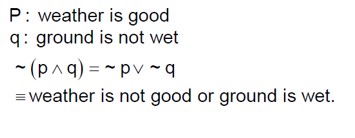Ncert Solutions Maths class 11th
Get insights from 1.6k questions on Ncert Solutions Maths class 11th, answered by students, alumni, and experts. You may also ask and answer any question you like about Ncert Solutions Maths class 11th
Follow Ask QuestionQuestions
Discussions
Active Users
Followers
New answer posted
3 months agoContributor-Level 10
x? + 2 (20)¹/? x³ + (20)¹/²x² + . No.
x² = - (20)¹/? x - (5)¹/².
α+β = - (20)¹/? , αβ=5¹/².
α²+β² = (α+β)²-2αβ = (20)¹/² - 2 (5)¹/² = 0.
α? +β? = (α²+β²)² - 2 (αβ)² = 0 - 2 (5) = -10.
α? +β? = (α? +β? )² - 2 (αβ)? = (-10)² - 2 (5)² = 100 - 50 = 50.
New answer posted
3 months agoContributor-Level 10
C= (2,3), O= (0,0). r = OC = √13.
Slope of OC = 3/2. Slope of PQ = -2/3.
Let P= (x, y). Vector CP = (x-2, y-3). Vector OC = (2,3).
CP.OC=0 ⇒ 2 (x-2)+3 (y-3)=0 ⇒ 2x+3y=13.
Also (x-2)²+ (y-3)²=13.
From 2x=13-3y, x= (13-3y)/2.
(13-3y)/2-2)²+ (y-3)²=13 ⇒ (9-3y)/2)²+ (y-3)²=13
(9 (y-3)²/4) + (y-3)² = 13 ⇒ (13/4) (y-3)²=13 ⇒ (y-3)²=4 ⇒ y-3=±2.
y=5 or y=1.
If y=5, x=-1. P= (-1,5).
If y=1, x=5. Q= (5,1).
New answer posted
3 months agoContributor-Level 10
? P? =? P? ⇒ n!/ (n-r)! = n!/ (n-r-1)! ⇒ n-r=1.
? C? =? C? ⇒ r + (r-1) = n ⇒ n = 2r-1.
Substitute n: (2r-1)-r=1 ⇒ r=2.
New answer posted
3 months agoContributor-Level 10
Reflected point of (2,1) about y-axis is (-2,1).
Reflected ray passes through (-2,1) and (5,3).
Equation: (y-1)/ (x+2) = (3-1)/ (5+2) = 2/7 ⇒ 2x - 7y + 11 = 0.
This is one directrix. Let the other be 2x - 7y + α = 0.
Distance between directrices = 2a/e = |11-α|/√53.
Distance from focus to directrix = a/e - ae = 8/√53.
a/e (1-e²) = 8/√53.
e=1/3. a/e (8/9) = 8/√53 ⇒ a/e = 9/√53.
2a/e = 18/√53 = |11-α|/√53.
|11-α| = 18.
11-α = 18 ⇒ α = -7.
11-α = -18 ⇒ α = 29.
Other directrix: 2x-7y-7=0 or 2x-7y+29=0.
New answer posted
3 months agoContributor-Level 10
cotθ = (1+cos2θ)/sin2θ
cot (π/24) = (1+cos (π/12)/sin (π/12)
cos (π/12) = cos (15°) = cos (45-30) = (√3+1)/2√2
sin (π/12) = sin (15°) = sin (45-30) = (√3-1)/2√2
cot (π/24) = (1+ (√3+1)/2√2)/ (√3-1)/2√2) = (2√2+√3+1)/ (√3-1)
= (2√2+√3+1) (√3+1)/2 = (2√6+2√2+3+√3+√3+1)/2
= √6 + √2 + √3 + 2
New answer posted
3 months agoContributor-Level 10
S? : x² + y² - x - y - 1/2 = 0, C? : (1/2, 1/2), r? = √ (1/4)+ (1/4)+ (1/2) = 1.
S? : x² + y² - 4y + 7/4 = 0, C? : (0, 2), r? = √ (4 - 7/4) = 3/2.
S? : (x-2)² + (y-1)² ≤ r², C? : (2, 1).
A ∪ B ⊂ C means both circles S? and S? must be inside S?
Distance C? = √ (2-1/2)² + (1-1/2)²) = √ (9/4 + 1/4) = √10/2.
Condition: r ≥ C? + r? ⇒ r ≥ √10/2 + 1.
Distance C? = √ (2-0)² + (1-2)²) = √5.
Condition: r ≥ C? + r? ⇒ r ≥ √5 + 3/2.
√10/2 + 1 ≈ 1.58 + 1 = 2.58.
√5 + 3/2 ≈ 2.23 + 1.5 = 3.73.
So minimum r = (√10+2)/2 and (2√5+3)/2. We need the maximum of these two.
Let's recheck the question logic f
New answer posted
3 months agoContributor-Level 10
Truth table analysis shows that (P ∨ Q) ∧ (¬P) is equivalent to Q ∧ ¬P.
Then (Q ∧ ¬P) ⇒ Q. This is a tautology.
The provided solution seems to have an error.
Let's check the options. (P ∨ Q) is a tautology. (P ∧ ¬Q) is a contradiction.
~ (P ⇒ Q) ⇔ P ∧ ¬Q is true.
New answer posted
3 months agoContributor-Level 10
sinθ + cosθ = 1/2
16 (sin (2θ) + cos (4θ) + sin (6θ)
= 16 [2sin (4θ)cos (2θ) + cos (4θ)]
= 16 [4sin (2θ)cos² (2θ) + 2cos² (2θ) - 1] . (i)
Now, sinθ + cosθ = 1/2, squaring on both sides, we get
1 + sin (2θ) = 1/4
sin (2θ) = -3/4
cos² (2θ) = 1 - sin² (2θ) = 1 - 9/16 = 7/16
From equation (i)
16 [4 (-3/4) (7/16) + 2 (7/16) - 1]
16 [-21/16 + 14/16 - 16/16] = 16 [-23/16] = -23
New answer posted
3 months agoContributor-Level 10
S? : |z - 3 - 2i|² = 8
|z - (3 + 2i)| = 2√2
(x - 3)² + (y - 2)² = (2√2)²
S? : Re (z) ≥ 5
x ≥ 5
S? : |z - z? | ≥ 8
|2iy| ≥ 8
2|y| ≥ 8
|y| ≥ 4
y ≥ 4 or y ≤ -4
From the graph of the circle (S? ) and the regions (S? and S? ), we can see that there is one point of intersection at (5, 4).
∴ n (S? ∩ S? ∩ S? ) = 1
Taking an Exam? Selecting a College?
Get authentic answers from experts, students and alumni that you won't find anywhere else
Sign Up on ShikshaOn Shiksha, get access to
- 65k Colleges
- 1.2k Exams
- 679k Reviews
- 1800k Answers

